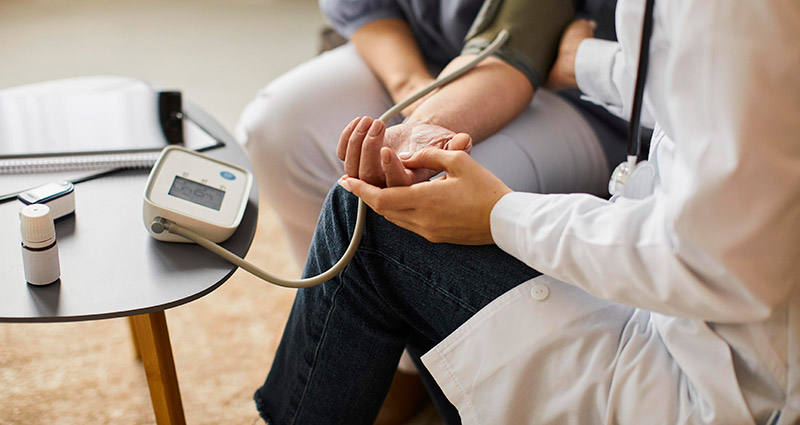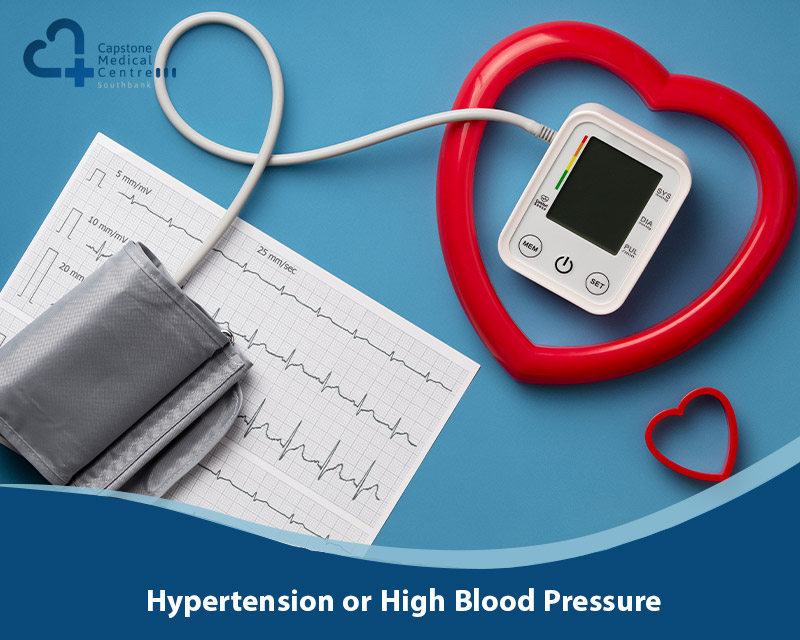Hypertension, commonly known as high blood pressure, is a medical condition when the force of blood against your artery walls is consistently too high. This condition is a significant health concern because it often presents no symptoms, yet it can lead to serious health complications such as heart disease and stroke if left unchecked.
Understanding and managing blood pressure is crucial for maintaining good health. Regular blood pressure monitoring can help detect hypertension early, providing timely intervention and treatment. Moreover, lifestyle modifications such as a healthy diet, regular exercise, and stress management can significantly control blood pressure levels.
This article from “Capstone Medical Centre“ aims to understand hypertension comprehensively. We will discuss the causes and symptoms of high blood pressure, the importance of regular monitoring, and explore various treatment options and lifestyle changes to help manage this condition.
What is Hypertension or high blood pressure?
Blood pressure is a crucial health indicator that measures the force exerted by the blood against the walls of the arteries. It is quantified as the systolic pressure over the diastolic pressure and is reported in millimetres of mercury (mmHg).
The systolic pressure represents the maximum pressure during the heart’s contraction, while the diastolic pressure signifies the minimum pressure when the heart is at rest between beats.
The American Heart Association classifies blood pressure into five categories:
| Blood Pressure Category | Systolic mm Hg (upper number) | Diastolic mm Hg (lower number) |
|---|---|---|
| Normal | Less than 120 | Less than 80 |
| Elevated | 120 – 129 | Less than 80 |
| Hypertension Stage 1 | 130 – 139 | 80 – 89 |
| Hypertension Stage 2 | 140 or higher | 90 or higher |
| Hypertensive Crisis | Higher than 180 | Higher than 120 |
Hypertension, or high blood pressure, is a global health concern. An estimated 1.28 billion adults aged 30–79 years worldwide have hypertension, with most living in low- and middle-income countries.
Nearly half of the adults globally have hypertension, defined as a systolic blood pressure greater than 130 mmHg or a diastolic blood pressure greater than 80 mmHg, or are taking medication for hypertension.
However, less than half of adults with hypertension are diagnosed and treated, and only about one in five adults with hypertension have it under control.
Given the silent nature of hypertension and its potential to lead to serious health complications such as heart disease and stroke, regular blood pressure checks are crucial for early detection and management.
Symptoms of Hypertension

High blood pressure is often called the “silent killer.” Unlike many other health problems, it usually doesn’t cause any noticeable symptoms, even when your blood pressure reaches dangerous levels. This can be very dangerous because it means people might not know they have a problem until it’s caused serious damage to their health.
No Symptoms, Big Risks
While most people with high blood pressure won’t feel any different, some potential warning signs can occur in very severe cases.
These include:
- Severe headaches
- Shortness of breath
- Nosebleeds
- Feeling very anxious or on edge
- Pulsating sensation in the neck or head
It’s important to remember that these symptoms aren’t specific to high blood pressure and can be caused by other things. They also usually don’t show up until the condition is quite serious.
Other, less specific symptoms like blood spots in the eyes, facial flushing, and dizziness might also be indirectly related to hypertension, but again, they’re not a surefire sign.
The Importance of Regular Checkups
Because high blood pressure often has no symptoms, checking your blood pressure regularly is crucial. This is a key part of preventive healthcare. It allows doctors to catch potential problems early and take steps to prevent them from getting worse.
How often do you need to have your blood pressure checked? Depends on your age, Overall health, and risk factors for high blood pressure.
For example, young adults with no risk factors might only need it checked every few years, while people with a higher risk or those over 40 might need it checked annually. Talk to your doctor about how often you should be screened.
Causes and Risk Factors

Primary hypertension, also known as essential hypertension, is a type of high blood pressure that develops gradually over many years and doesn’t have an identifiable cause.
It’s often due to lifestyle factors, such as:
- an unhealthy diet
- lack of exercise
- chronic stress, smoking
- or heavy drinking.
Secondary hypertension is high blood pressure caused by another medical condition. It can be caused by conditions that affect the kidneys, arteries, heart, or endocrine system. For instance, certain kidney diseases may cause secondary hypertension, including:
- diabetes complications (diabetic nephropathy)
- Polycystic kidney disease
- Glomerular disease
- and renovascular hypertension.
Other medical conditions affecting hormone levels can also cause secondary hypertension, such as:
- adrenal disease
- thyroid problems
- and obstructive sleep apnea.
There are several risk factors associated with hypertension. Some of these are non-modifiable, such as age and genetics. Blood pressure tends to increase with age, and a family history of hypertension can increase one’s risk.
Modifiable risk factors include lifestyle habits and certain circumstances. These include:
- being overweight or obese
- having a diet high in salt
- drinking too much coffee and other forms of caffeine
- having a family history of high blood pressure
- lack of physical activity
- having alcohol use disorder
- and having sleep issues, such as insomnia.
Complications
Untreated hypertension, commonly known as high blood pressure, poses significant risks to overall health. It’s often called a “silent killer” because it can cause substantial damage to the body over time without noticeable symptoms.
Cardiovascular Health
High blood pressure can lead to severe damage to arteries, increasing the risk of heart disease, heart attacks, and strokes. The heart is strained by the increased workload from high blood pressure, potentially resulting in enlargement and insufficient blood supply to the body.
Treating hypertension effectively could prevent millions of deaths, strokes, heart attacks, and cases of heart failure.
Effects on Other Organs
Hypertension can also adversely affect other organs, notably the kidneys and eyes. It damages kidney arteries, impairing blood filtration and potentially causing kidney disease or failure.
Blood vessel strain or eye damage due to high blood pressure can result in vision loss, including conditions like hypertensive retinopathy. Kidney disease can also lead to vision loss, a reversible condition known as uremic optic neuropathy.
Diagnosis
Diagnosing high blood pressure involves several methods and tests to accurately assess blood pressure levels and potential underlying issues.
The primary method for measuring blood pressure is using a device called a sphygmomanometer. This instrument includes a cuff that is typically wrapped around the arm. The cuff is then manually inflated with a hand pump or automatically with a machine.
A blood pressure reading consists of two numbers:
- The systolic pressure (measured when the heart beats)
- The diastolic pressure (measured between heartbeats)
During the initial assessment, it’s important to check blood pressure in both arms to identify any differences. Subsequent readings should be taken from the arm with the higher recorded pressure. Diagnosis of high blood pressure usually requires averaging two or more readings obtained on separate occasions.
In addition to blood pressure measurements, diagnostic tests may involve blood tests to assess kidney function (measuring electrolytes, blood urea nitrogen, and creatinine levels), lipid profile (evaluating cholesterol levels), and specialised tests for adrenal or thyroid gland hormones. Urine tests may also be conducted to analyse electrolytes and hormones.
Various methods are recommended for detecting hypertension, including:
- Office blood pressure measurements (OBPM),
- Automatic office blood pressure monitoring for 30 minutes (OBP30),
- ambulatory home blood pressure measurements (HBPM),
- and 24-hour ambulatory blood pressure monitoring (24 H-ABPM).
Accurate measurement and recording of blood pressure are crucial for determining the severity of hypertension, assessing cardiovascular disease risk associated with high blood pressure, and guiding treatment decisions.
Blood pressure levels fluctuate throughout the day, emphasising the importance of consistent and repeated measurements over time for an accurate diagnosis and effective management of hypertension.
Treatment Options

Lifestyle Modifications
1. Diet and Nutrition: The Dietary Approaches to Stop Hypertension (DASH) diet is recommended for people with hypertension. It focuses on fruits, vegetables, whole grains, low-fat dairy, fish, poultry, beans, and nuts, and limits salt, sugar, and saturated fat. Sodium reduction is also crucial in managing hypertension.
2. Weight Management and Physical Activity: Regular physical activity helps control high blood pressure, manage weight, and lower stress levels.
3. Stress Reduction Techniques: Managing stress is vital to hypertension treatment. Techniques can include getting enough sleep, learning relaxation techniques like meditation and deep breathing, strengthening your social network, honing your time-management skills, nurturing yourself, and asking for help.
Medications for Hypertension Management
- Types of Medications: The primary medications for treating high blood pressure are:
- thiazide diuretics
- ACE inhibitors
- beta-blockers
- calcium channel blockers
Some common ACE inhibitors include:
- benazepril (Lotensin)
- captopril
- enalapril (Vasotec)
- fosinopril
- lisinopril (Zestril)
- moexipril
- perindopril
2. Considerations for Medication Adherence and Side Effects: Medication adherence is crucial for managing high blood pressure. Non-adherence can lead to adverse health outcomes and increased healthcare costs. Factors that can improve adherence include modifying patients’ beliefs and behaviour, providing positive reinforcement, allowing patients to speak freely, and understanding and addressing their concerns or fears.
Remember, it’s important to discuss all of these treatment options with your healthcare provider to determine the best approach for you. They can provide more detailed information and guidance based on your specific circumstances and health condition.
Prevention
Early Intervention and Prevention
Early intervention and prevention are crucial in managing hypertension. Lifestyle modifications or pharmaceutical treatments initiated early can reduce the incidence of hypertension and the risk of subsequent cardiovascular disease. Therefore, identifying individuals at risk for hypertension provides an opportunity for early intervention.
Healthy Lifestyle Choices
Adopting healthy lifestyle habits can help prevent high blood pressure. These include:
- Diet and Nutrition: Follow a healthy diet rich in fruits, vegetables, and low-fat dairy foods. Limit foods high in saturated fat, cholesterol, and trans fats. The DASH (Dietary Approaches to Stop Hypertension) diet is recommended for people with hypertension.
- Physical Activity: Regular physical activity helps keep weight in check and reduces your odds of many different heart problems.
- Weight Management: Maintaining a healthy weight is critical in managing hypertension.
- Limit Alcohol and Caffeine: Regularly drinking too much alcohol or caffeine can raise your blood pressure.
- Quit Smoking: Smoking damages blood vessels and can increase your blood pressure.
- Stress Management: Many people find yoga, meditation, music, and tai chi helpful in managing stress.
Screening Guidelines for Blood Pressure Monitoring
In Australia, doctors follow guidelines set by the Royal Australian College of General Practitioners (RACGP). Here’s a quick summary:
- Everyone 18 and older should get their blood pressure checked at least every two years.
- For people over 45 (or 35 for Indigenous Australians), doctors consider your overall heart disease risk when interpreting your blood pressure.
- Home monitoring is encouraged using a validated device with an upper arm cuff. Take two readings, morning and evening, for at least five days after resting quietly.
These guidelines help with early detection and management of high blood pressure. Remember, talk to your doctor about any questions or concerns you have.
Special Considerations
Men’s Health
1. Unique Risk Factors and Considerations for Men: Men have unique risk factors for hypertension. Lifestyle and environmental factors such as a sedentary lifestyle, poor diet, stress, and age (it’s more common after 50 years of age) can contribute to the development of hypertension.
Other factors include smoking, being overweight or obese, excessive alcohol consumption, and stress.
2. Impact of Hypertension on Men’s Health: Hypertension can lead to plaque buildup in the arteries leading to the brain, a condition known as atherosclerosis. This can increase the risk of stroke. Hypertension can also cause erectile dysfunction, a common issue in men with uncontrolled high blood pressure.
Women’s Health
1. Hormonal Influences on Blood Pressure: Female sex hormones, particularly estradiol, significantly influence blood pressure regulation. Estradiol contributes to lower blood pressure and a smaller risk of hypertension seen in young women compared to young men.
However, hormonal influences change over the lifespan, and blood pressure can increase in women after menopause.
2. Pregnancy-Related Hypertension (Preeclampsia): Preeclampsia is a serious blood pressure condition that can develop during pregnancy. It typically begins after 20 weeks of pregnancy in women whose blood pressure had previously been normal.
Preeclampsia is characterised by high blood pressure and signs of damage to other organ systems, most often the liver and kidneys. If left untreated, it can lead to serious complications for both the mother and baby.
The bottom line
In conclusion, managing hypertension effectively requires proactive measures and regular monitoring of blood pressure levels. It’s crucial to seek medical advice and support from healthcare professionals, such as those at Capstone Medical Centre, to ensure optimal management of this condition.
Sources:


1 thought on “Hypertension or High Blood Pressure: Symptoms, Causes and Treatment”
Comments are closed.